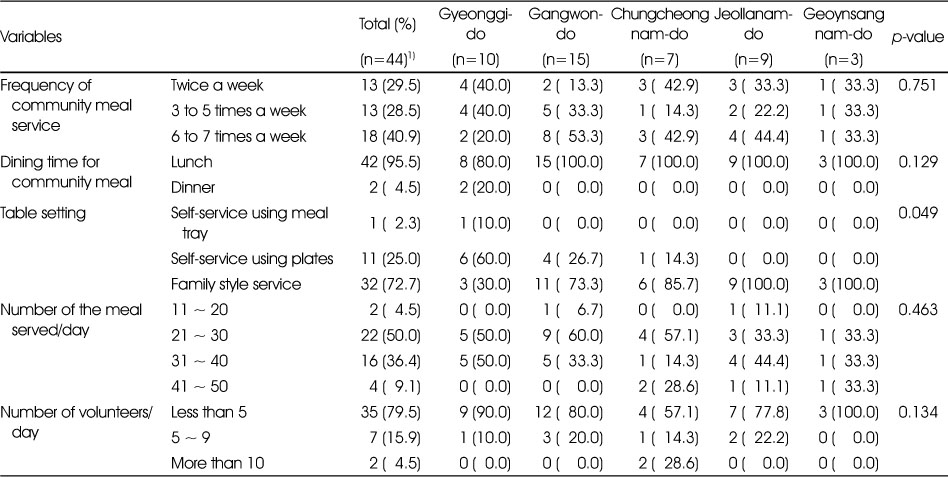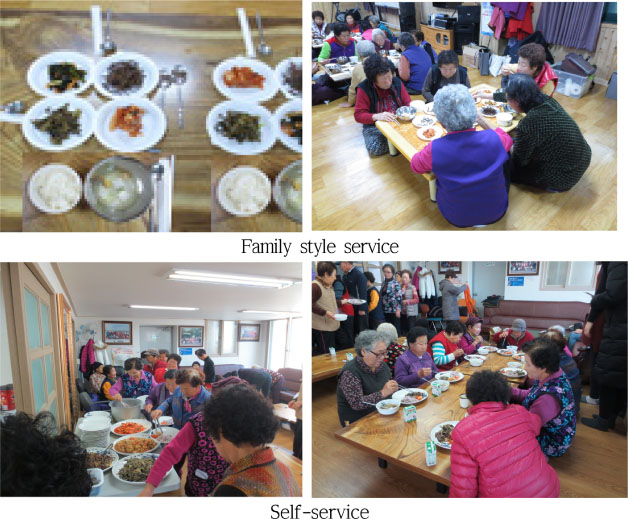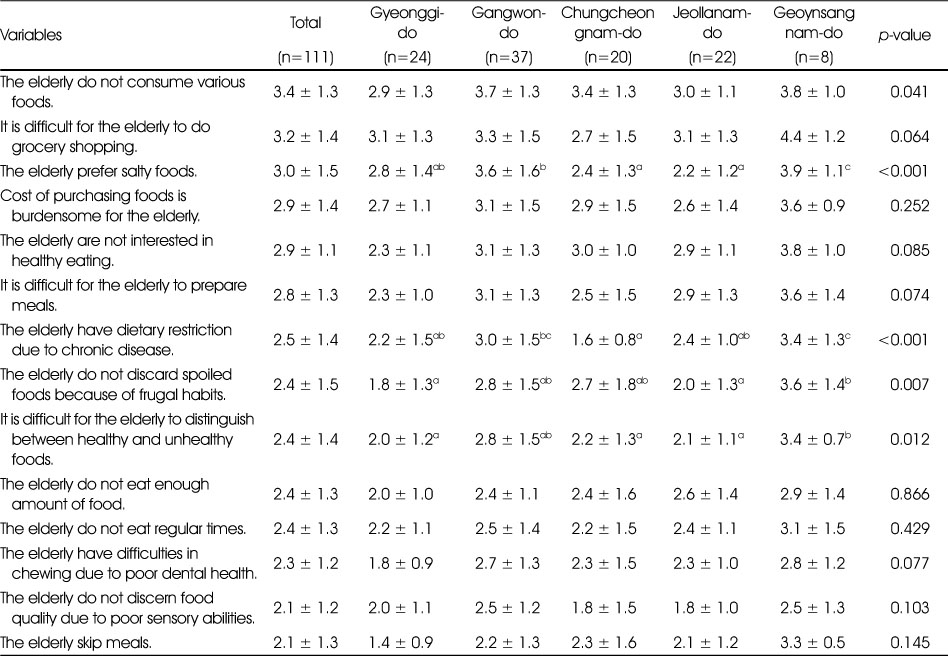Articles
- Page Path
- HOME > Korean J Community Nutr > Volume 24(4); 2019 > Article
-
Research Article
- Operation and Process Evaluation of a Community Meal Program for the Elderly in Rural Areas during Agricultural Off-Season Perceived by Cooking Volunteers
-
Jeong-Sook Bae
 , Sol-Bee Seong
, Sol-Bee Seong , So-Mang Jang
, So-Mang Jang , Chang-Hee Yoo
, Chang-Hee Yoo , Young-Suk Lim
, Young-Suk Lim , Young-Mi Lee
, Young-Mi Lee , Hae-Ryun Park
, Hae-Ryun Park , Kyung-Eun Lee
, Kyung-Eun Lee
-
Korean Journal of Community Nutrition 2019;24(4):277-289.
DOI: https://doi.org/10.5720/kjcn.2019.24.4.277
Published online: August 31, 2019
1Major of Food and Nutrition, Seoul Women's University, Seoul, Korea, Graduate Student.
2Major of Food and Nutrition, Seoul Women's University, Seoul, Korea, Visiting Professor.
3Department of Food and Nutrition, Myongji University, Yongin, Gyeonggi, Korea, Research Professor.
4Department of Food and Nutrition, Myongji University, Yongin, Gyeonggi, Korea, Professor.
5Major of Food and Nutrition, Seoul Women's University, Seoul, Korea, Professor.
- Corresponding author: Kyung-Eun Lee. Major of Food and Nutrition, Seoul Women's University, 621 Hwarang-ro, Nowon-gu, Seoul 01797, Korea. Tel: (02) 970-5648, Fax: (02) 976-4049, klee@swu.ac.kr
Copyright © 2019 The Korean Society of Community Nutrition
This is an Open-Access article distributed under the terms of the Creative Commons Attribution Non-Commercial License (http://creativecommons.org/licenses/by-nc/3.0/) which permits unrestricted non-commercial use, distribution, and reproduction in any medium, provided the original work is properly cited.
- 817 Views
- 6 Download
- 3 Crossref
Abstract
-
Objectives
- This study examined the practices of a community meal program for older adults in rural areas during the agricultural off-season.
-
Methods
- A survey was conducted from December 12 to December 22, 2016. Self-administered questionnaires were distributed to 150 cooking volunteers, who had participated in the community meal program in 50 villages. A total of 114 responses were returned from 44 villages and used for data analysis. In addition, in-depth interviews were conducted with the volunteers of eight villages.
-
Results
- Most of the cooking volunteers were 50 years old or older and they participated in serving older adults meals for good will. The cooking volunteers perceived that the older adults in their community did not eat various foods, had difficulties in grocery shopping, and frequently consumed salty foods. During the agricultural off-season, 40.9% of villages served the older adults meals 6–7 days a week and 95.5% provided meals for lunch. An average of 21 to 40 older adults were served meals in each village. The cooking volunteers reported that the food preparation and meal service times were sufficient, recipes provided were useful, and menus met the preference of the older adults. At the end of the program, they felt proud of serving meals for older adults in the community. An increased awareness of healthy eating, interest in health, and consumption of nutritious meals, a decrease in loneliness among older adults, and the promotion of fellowship in the community were rated highly. The cooking volunteers expected additional support for cooking personnel and insisted that the program should be provided for the entire agricultural off-seasons.
-
Conclusions
- The community meal program during the agricultural off-season for the elderly in rural areas was effective in improving the dietary life of older adults, relieving their feelings of isolation, and promoting fellowship of the community. The volunteers felt workload due to a shortage of volunteers but answered that they were rewarded by helping older adults in their community.
Acknowledgments
Acknowledgments
- 1. Statistics Korea. Statistics list [Internet]. Statistics Korea; 2018; cited 2019 May 10]. Available from: https://www.kostat.go.kr/.
- 2. Kang NE, Lee JY. The analysis of effect on nutrition education program for the elderly in Sung-nam area. Korean J Food Nutr 2005; 18(4): 357-366.
- 3. Heo YR, Shin JH, Kim KS, Kim BH. Development and application of a community-based meal program model for the elderly in rural area. J Korean Diet Assoc 2008; 14(1): 23-35.
- 4. Kim Y, Seo SH, Kwon OR, Cho MS. Comparisons of dietary behavior, food intake, and satisfaction with food-related life between the elderly living in urban and rural areas. Korean J Nutr 2012; 45(3): 252-263.Article
- 5. Kim HY, Kim GH, Kim HR, Kim YS. Menu development and application for rural elderly of Gangwon and Chungnam areas at agricultural off-season. Korean J Community Living Sci 2009; 20(3): 423-435.
- 6. Lee Y, Choi Y, Park HR, Song KH, Lee KE, Yoo CH, et al. Comparative analysis of dietary behavior and nutrient intake of elderly in urban and rural areas for development of “Village Lunch Table” program: Based on 2014 Korea National Health and Nutrition Examination Survey data. J Nutr Health 2017; 50(2): 171-179.ArticlePDF
- 7. Chun JD, Ryu SY, Han MA, Park J. Comparisons of health status and health behaviors among the elderly between urban and rural areas. J Agric Med Community Health 2013; 38(3): 182-194.Article
- 8. Byker Shanks C, Haack S, Tarabochia D, Bates K, Christenson L. Factors influencing food choices among older adults in the rural western USA. J Community Health 2016; 42(3): 511-521.ArticlePDF
- 9. Chae HS, Yoon SD, Lee GS, Kim HC. Effectiveness evaluation of the education program to take care of the elderly in the rural area. J Agric Ext Community Dev 2009; 16(1): 1-20.
- 10. Yoon JS, Song MK, Lee HJ, Lee SY, Cho HK, Choi YJ. An evaluation of the dietary status for developing assistance programs for daily lives of elderly individuals in rural Korea. Korean J Community Living Sci 2014; 25(2): 163-173.Article
- 11. Kim HY, Park CE, Lee HJ, Park YH, Lee JY. A study on the menu development for the elderly during busy farming season in Gyeongbuk Andong. J Korean Soc Food Sci Nutr 2009; 38(10): 1381-1391.Article
- 12. Chung EJ, Shim EG. Comparison of health status and nutrient intakes of elders who participated in mow and free congregate meal services. J Korean Soc Food Sci Nutr 2007; 36(11): 1399-1408.Article
- 13. Lee KE, Yi NY, Park JY. Food safety knowledge and home food safety practices of home-delivered meal service recipients. J Korean Soc Food Sci Nutr 2009; 38(5): 618-625.Article
- 14. Cha GH, Kim JS, Park HR, Park HS, Youn SJ, Park JH. A study on the eating habits and food preference of the elderly in Jeonju, North Jeolla province. Food Eng Prog 2016; 20(1): 35-52.ArticlePDF
- 15. Kim SW, Shin JH, Sohn SJ, Heo YR, Kang MG. Effect of nutrition support program for the elderly in a rural community. J Agric Med Community Health 2009; 34(1): 113-123.Article
- 16. Park JS, Oh YJ. The effects of a health promotion program in rural elderly on health promotion lifestyle and health status. J Korean Acad Nurs 2005; 35(5): 943-954.ArticlePDF
- 17. Park MY, Chun BY, Joo SJ, Jeong GB, Huh CH, Kim GR, et al. A comparison of food and nutrient intake status of aged females in a rural long life community by the stage model of dietary behavior change. Korean J Community Nutr 2008; 13(1): 34-45.
- 18. Park PS, Chun BY, Jeong GB, Huh CH, Joo SJ, Park MY. The effect of follow-up nutrition intervention programs applied aged group of high risk undernutrition in rural area (I). Korean J Food Cult 2007; 22(1): 127-139.
- 19. Choi YJ, Kim C, Park YS. The effect of nutrition education in program in physical health, nutritional status and health-related quality of the elderly in Seoul. Korean J Food Cult 2007; 40(3): 270-280.
- 20. Park HJ, Lim BK, Kim WY. Effect of food commodity supplementary program for low income elderly people. Korean J Food Cult 2007; 22(1): 149-156.
- 21. Kim MK, Han JI, Chung YJ. Dietary behavior related to salty food intake of adults living in a rural area according to saline sensitivity. Korean J Nutr 2011; 44(6): 537-550.Article
- 22. Kawano Y. Salt, hypertension, and cardiovascular diseases. J Korean Soc Hypertens 2012; 18(2): 53-62.Article
- 23. Lee MS. The relationship between dietary behaviors/health risk factors and preference for salty taste among Korean elderly people living in rural areas. Korean J Community Nutr 2014; 19(5): 448-458.Article
- 24. Han KH, Choi MS, Park JS. Psycho-social, nutritional status and meal service utility patterns by living arrangements of the elderly participated in meal service. Korean J Community Nutr 2004; 9(5): 615-628.
- 25. Ye M, Chen L, Kahana E. Mealtime interactions and life satisfaction among older adults in Shanghai. J Aging Health 2017; 29(4): 620-639.ArticlePubMedPDF
- 26. Lim JG. The effects of social support on life satisfaction among the elderly: focusing on the difference between rural and urban area. Korean J Soc Welf Res 2013; 38: 217-240.
REFERENCES
Operations of community meal program for the elderly in rural areas during agricultural off-season

Practices of the community meal program for the elderly in rural areas perceived by cooking volunteers by region

Figure & Data
REFERENCES
Citations

- An Interactive Live and Online Cooking Program for Children in Vulnerable Families—An Exploratory Study
Jiyoung Park, Sein Hwang, Seolhyang Baek, Gill A. Ten Hoor
Healthcare.2022; 10(12): 2389. CrossRef - Disparities in dietary quantity and quality between the two different types of Korean family of older adults living with spouses and living alone: using data from the 6th Korea National Health and Nutrition Examination Survey
Yu Rim Choi, Hae Ryun Park, Kyung Hee Song, Youngmi Lee, Young Suk Lim
Nutrition Research and Practice.2020; 14(3): 242. CrossRef - Patient-centered counseling program using health coaching to promote self-care among elderly hypertension patients in the rural area of South Korea
HeyJean Lee, Jung Min Kim, Ji Young Moon
Korean Journal of Health Education and Promotion.2020; 37(2): 99. CrossRef

Fig. 1
General characteristic of cooking volunteers
Operations of community meal program for the elderly in rural areas during agricultural off-season
1) Number of village
Dietary problems of the rural elderly perceived by cooking volunteers
A 5-point Likert scale was used from 1 (strongly disagree) to 5 (strongly agree).
abc: Different superscripts within the same row mean significant differences by Duncan's post-hoc test (p<0.05).
Practices of the community meal program for the elderly in rural areas perceived by cooking volunteers by region
A 5-point Likert scale was used from 1 (strongly disagree) to 5 (strongly agree).
abc: Different superscripts within the same row mean significant differences by Duncan's post-hoc test (p<0.05).
Practices of the community meal program for the elderly in rural areas perceived by cooking volunteers by their age, number of meals/day, and number of volunteers
A 5-point Likert scale was used from 1 (strongly disagree) to 5 (strongly agree).
abc: Different superscripts within the same row mean significant differences by Duncan's post-hoc test (p<0.05).
The effectiveness of community meal program for the elderly in rural areas perceived by cooking volunteers
1) Number of village
A 5-point Likert scale was used from 1 (strongly disagree) to 5 (strongly agree).
1) Number of village
A 5-point Likert scale was used from 1 (strongly disagree) to 5 (strongly agree). abc: Different superscripts within the same row mean significant differences by Duncan's post-hoc test (p<0.05).
A 5-point Likert scale was used from 1 (strongly disagree) to 5 (strongly agree). abc: Different superscripts within the same row mean significant differences by Duncan's post-hoc test (p<0.05).
A 5-point Likert scale was used from 1 (strongly disagree) to 5 (strongly agree). abc: Different superscripts within the same row mean significant differences by Duncan's post-hoc test (p<0.05).
1) Number of village A 5-point Likert scale was used from 1 (strongly disagree) to 5 (strongly agree).

 KSCN
KSCN





 PubReader
PubReader Cite
Cite


